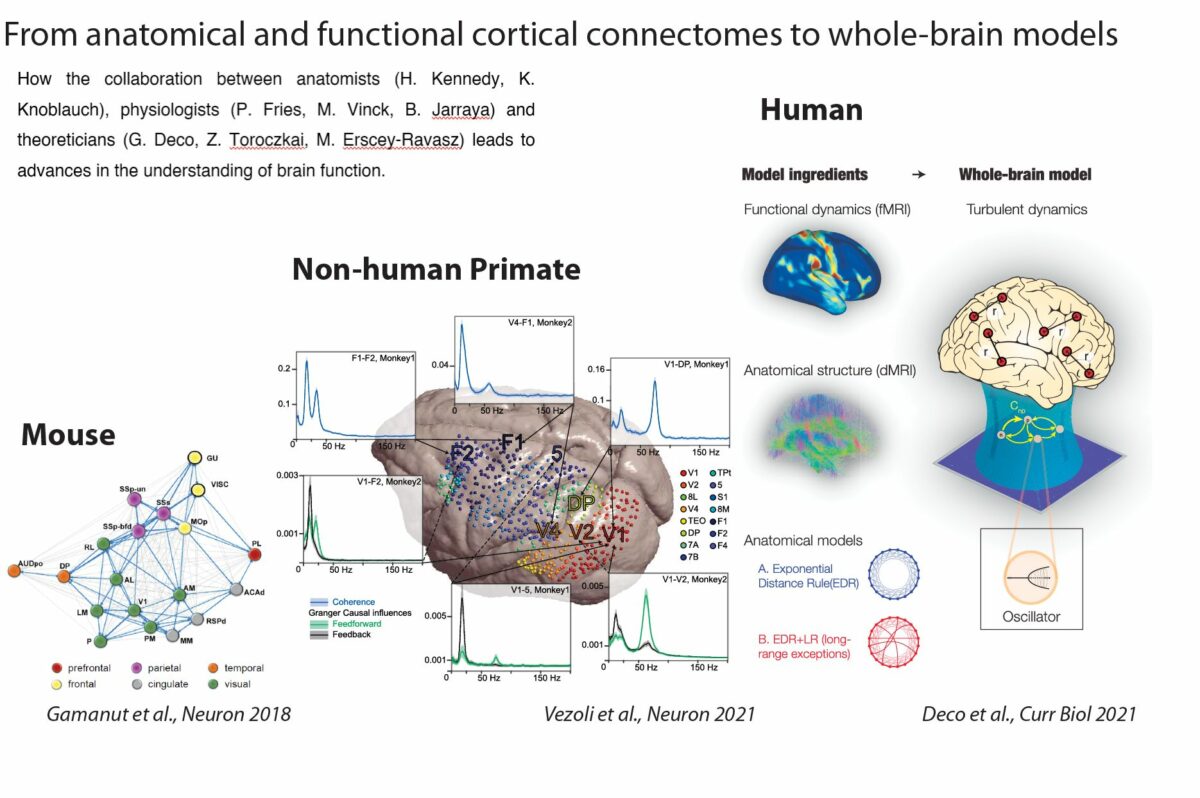

CORTICITY: Comparative Investigation of the Cortical Circuits in Mouse, NHP and Human
In order to further the understanding of the mechanisms by which neural interactions sustain different states of awareness, we have studied principles of cortical organization at the structural and functional levels and develop data-driven statistical models in order to study brain activity in different brain states using dynamical systems modeling whole-brain networks, in combination with analyses of brain activity from human, non-human primates, and rodents. The project required tight collaborations between physiologists, anatomists and theoreticians. Invasive techniques for anatomical and physiological investigations in mouse and macaque allowed the extraction of empirical data and the identification of fundamental principles on cortical organization, both essentials for the development of whole-brain models and large-scale simulations. These whole-brain models simulate various neuronal populations producing different types of functional dynamics in a defined anatomical network. Comparison between simulations from whole-brain models and non-invasive recordings in macaques and humans allowed the identification of functional and structural principles of the cognitive architecture in human and non-human primates subtending different states of consciousness.
CORTICITY led to two patent applications and numerous high-quality publications including 7 outstanding publications in Neuron, Nature Communications, Current Biology with 32 publications combining 7 teams of the consortium: Using tract-tracing electrophysiological measures of brain activity in mouse and non-human primate we have identified architectural principles of the mammalian connectome and how it shapes functional interactions (D’Souza et al. 2022, Nature Communications; Vezoli et al. 2021, Neuron; Froudist-Walsh et al. 2021, Neuron; Hayashi et al. 2021, Neuroimage; Vezoli et al. 2021 Neuroimage; Gămănut et al. 2018, Neuron). Using whole-brain models we have shown that the structure of brain connectivity – specially, the core-periphery architecture and the presence of long-range connections – together with heterogeneous dynamics across brain regions highly determine the brain dynamics at different states of consciousness (Deco et al. 2021, Current Biology; López-González et al. 2021, Nature Communications Biology; Hahn et al. 2021, NeuroImage; Signorelli et al. 2021, NeuroImage). Moreover, the models explain the differences in the brain’s responsiveness and information capacity observed in different brain states of human and animal neural activity (Ponce-Alvarez et al. 2021, Cerebral Cortex; Ponce-Alvarez et al. 2020, eLife; Jobst et al. 2021, NeuroImage). In particular, using tools from statistical mechanics, we showed that transitions between states of consciousness relate to phase transitions and primarily depend on changes in population couplings of specific brain regions (Ponce-Alvarez et al. 2021, Cerebral Cortex). Finally, we identified specific circuit mechanisms for shaping cortex-wide network interactions by key neuromodulatory systems (Pfeffer et al. 2021, Science Advances).
Altogether, these studies contribute to understand how neural network effects sustain different brain states and determine their information capabilities in terms of neural communication, responsiveness, and information capacity. The anatomical and physiological datasets will be integrated into the European neuroinformatic platform EBRAINS, allowing refinement of simulations and brain models already available.
